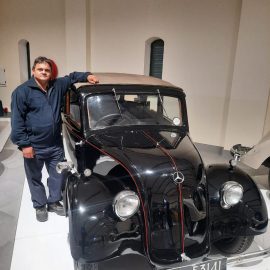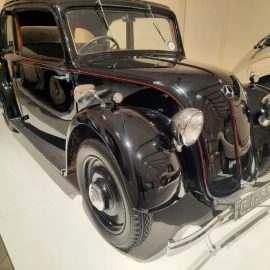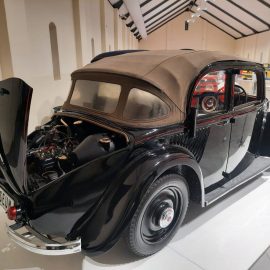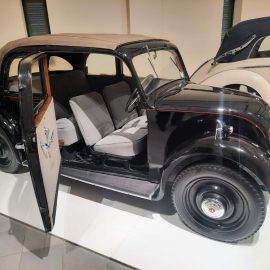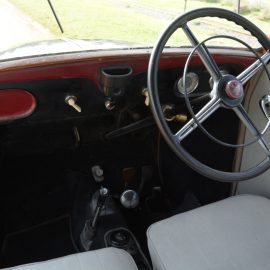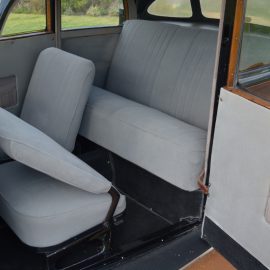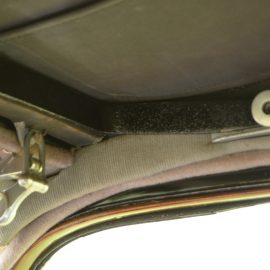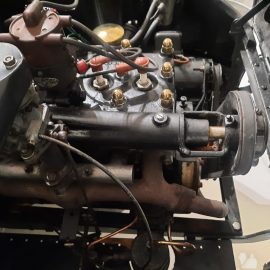
28 Jun Spanner Works: Donnie and Michael
A regular feature, outlining the activities of FMM’s workshop personnel who are responsible for repairing, renovating, refurbishing and restoring the museum’s large and varied collection of vehicles. This month we report on Donnie and Michael reviving a ground-breaking Mercedes…
If you were asked what was the first production-volume German car to feature a rear-mounted engine, would you have said the Volkswagen Beetle? You’d surely be forgiven for thinking that, but, in fact, it was a Mercedes-Benz. The 130H was launched at the IAMA (Internationale Automobil-Ausstellung) motor show in Berlin in 1934, with production starting shortly after in the same year. The first Volkswagen Beetle rolled out of Wolfsburg in 1938.
With the 35th National Gathering of the Mercedes-Benz Club of South Africa being planned, we decided to get some of the rare old Mercs out of the collection and made ready for display, including the 130H, which at the time was in storage. Having not been started or run in years, it was up to Donnie Tarentaal to inspect the car and take on the mechanical revival.
Firstly, Donnie tackled the baseline timing and firing order. The spark plugs were removed and while turning over the engine, used his thumb to check which cylinders fired when. Thus, it was established that the firing order had been incorrectly set up initially. With the timing and firing order corrected, the 130H was started, but some other issues reared their ugly heads. These included a chronic water leak that needed fixing, a water pump shaft that had corroded to a level that it needed replacement, and some of the engine cowling plates were missing. For the latter, templates were made in cardboard to match the gaps between the engine and the bodywork, and then new plates were fabricated from the template patterns and coated with fresh paint.
The water pump is located towards the radiator, which is on the firewall side of the engine bay. This meant that the engine had to be removed to access the pump, disconnect the corroded shaft and to inspect the radiator. It was decided to send the shaft to an engineering works to be remanufactured from new material. While this was going on, Michael van Graan removed the fuel tank to clean out the inside and give it a fresh coating of anti-corrosion liner.
Upon its return, it was found that the water pump shaft was slightly over size and did not fit. After consulting with curator Wayne and workshop manager Lorenzo, it was decided that Donnie turn it down to size on the workshop lathe, as to send it back to the engineers would take too much time for such a simple task. Once done, it was then installed and fitted perfectly, while the radiator was flushed and reinstalled.
With the engine sorted and running well, it was decided that Michael, our in-house panel beater, perform a complete bodywork restoration to its original colour – Schwartz. The paint was cracked in a few areas and it was evident that someone in the history of this vehicle had taken to the cosmetics with a liberal amount of body filler… So, Michael set about removing the interior, bad paint, body filler and dents over which it was applied.
Whenever the paint and filler coatings are removed from an old car, various other hidden problems are revealed and this car proved no different. Besides dents in the panels, there were also some spots of rust along the window sills, and seat rails that had to be repaired with newly fabricated metal sections. The doors also hung unevenly, which required some panel beating and repair of the pillars. The hinges were shimmed with spacers in order to align the panel gaps properly.
With bodywork prepared, it was time to paint. The car was spray-painted inside and out with fresh coats of black paint. After drying, it was finished off with various grades of sanding and, finally, polishing. Michael then fitted new rubbers on the sills, after which he started refitting the interior.
Firstly, the original roof lining was refitted, as it was still in good condition. Then, new carpeting was prepared and glued to the floor. The seats had been sent away for recovering in a period-correct type cloth material and completed the refreshed interior beautifully.
As it turned out, the Mercedes-Benz Club gathering in Graaff-Reinet never materialised (it was postponed indefinitely due to COVID). However, thanks to the efforts of Donnie and Michael, the Museum’s 1935 Mercedes-Benz 130H stands proudly on display in Hall B.




